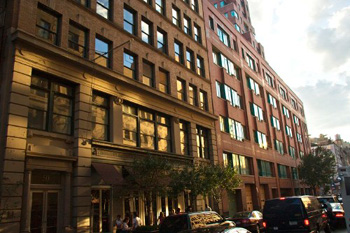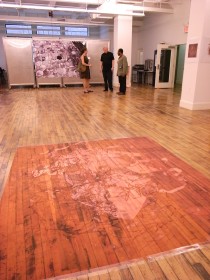NEW YORK CITY
Architecture seminar explores NYC's 'Common Ground'

The College of Architecture, Art and Plannings New York City Center, at 50 W. 17th St. in Manhattan. See larger image
Cornell's 14 graduating Master of Architecture II (M.Arch.2) students held their final design research seminar this summer at the College of Architecture, Art and Planning's New York City studio. M.Arch.2 is a three-semester, post-professional degree program for architecture students who have an accredited bachelor or master of architecture degree and some professional experience. Students can focus on one of five areas of investigation: discourse, urbanism, media, technology or ecology.
The 10-week seminar was led by program coordinator and visiting assistant professor Mark Morris, with the participation of Cornell faculty Mary Woods, Christian Otto and Henry Richardson; and invited critics including Kathy Battista, education program director at Sotheby's. For their two-week module, "Common Ground," visiting critics Lebbeus Woods and Christoph a. Kumpusch focused on examining urban life and themes inspired by various New York City locations.
"If we can interpret this common ground, we can interpret relevant but previously hidden dimensions of living in the city," Woods said. "This is the ground surface of streets, sidewalks, parks, plazas and other -- even informal -- public spaces, comprising the ground plane we share with others we do not personally know."

Visiting critic Lebbeus Woods, middle, confers with guest critics Shannon Mattern, professor of media studies and film at Parsons The New School of Design, and Anthony Titus, professor at Cooper Union. In the background is a Common Ground project by student Bogeng Chen and in the foreground, an installation by Joshua Nason. See larger image
During one two-week module, students studied ordinary city surfaces and environments -- sidewalks, pavement, parks, noises and markings on streets -- that could be interpreted to help depict the rich and diverse lives and everyday scenarios taking place within the cityscape.
Manasi Pandey, from Gujurat, India, spoke highly of the seminar and the program as she presented "Ephemerality," a digital collage of photos depicting a new world emerging and disappearing on puddles of water as the water evaporates. "During the one-year program, I was able to focus on my chosen discipline while investigating other interesting and relevant topics to push my experience and knowledge as an architect," she said. Pandey also acknowledged the assistance of financial support from the university.
For his interactive project "Body Politics," Texan Joshua Nason imagined a world without divisions or boundaries, where people and space bleed into one another to become one. Nason, who plans to teach architecture, said he was drawn to the program's "balance of structure and creativity and its strength in theory and criticism. I wanted a school that challenged me, and Cornell offered just that."
Also joining the final discussion were Miodrag Mitrasinovic, Urban and Transdisciplinary Design Chair at Parsons The New School for Design; Shannon Mattern, media studies and film professor at The New School; and Anthony Titus, professor at Cooper Union's Irwin S. Chanin School of Architecture.
AAP NYC offers undergraduate and graduate students an opportunity to live and study in a vital urban center, with a full roster of courses and access to New York City's artistic, historical and cultural resources. For more information, visit aap.cornell.edu/nyc. For information on the M.Arch.2 program, visit aap.cornell.edu/arch/programs/marchpost.cfm.